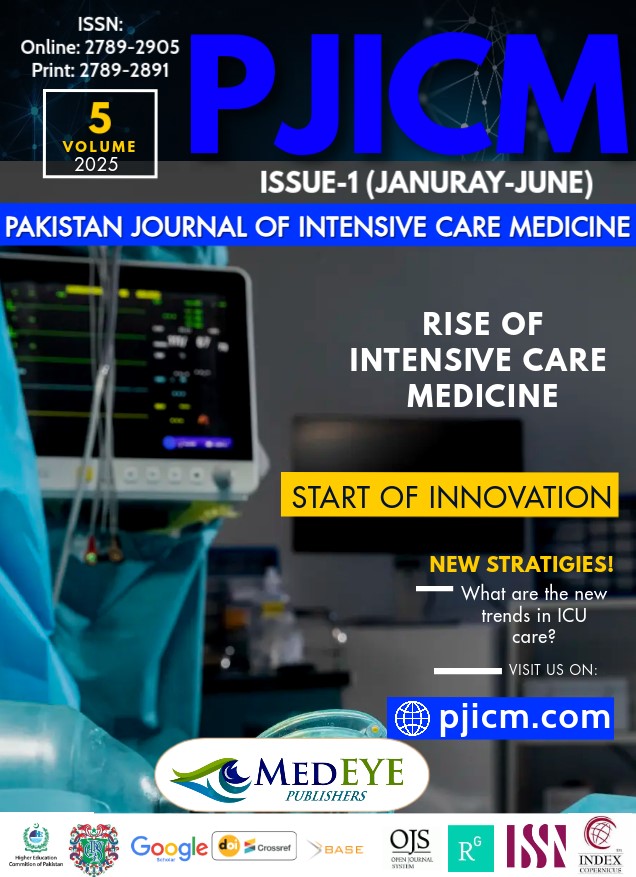FREQUENCY AND BACTERIOLOGICAL SPECTRUM OF SPONTANEOUS BACTERIAL PERITONITIS IN PATIENTS PRESENTING WITH DECOMPENSATED CIRRHOSIS TO A TERTIARY CARE HOSPITAL
DOI:
https://doi.org/10.54112/pjicm.v5i01.59Keywords:
Spontaneous Bacterial Peritonitis Decompensated Cirrhosis Bacteriological Profile Antibiotic Resistance Tertiary Care HospitalAbstract
Background: Spontaneous bacterial peritonitis (SBP) is a severe and common infection in patients with decompensated cirrhosis, contributing significantly to morbidity and mortality. Early identification and understanding of causative organisms are crucial for targeted therapy and better patient outcomes. Objective: To assess the frequency of spontaneous bacterial peritonitis and the distribution of bacterial pathogens in patients presenting with decompensated cirrhosis. Study Design: Cross-sectional study. Setting: The study was conducted at the Department of General Medicine, MTI-Lady Reading Hospital, Peshawar. Duration of Study: 13 December 2024 to 13 March 2025. Methods: A total of 101 patients with decompensated cirrhosis were enrolled. Ascitic fluid analysis was performed to diagnose SBP based on polymorphonuclear leukocyte (PMN) count ≥250 cells/mm³ and positive bacterial cultures. Patient demographics, clinical history, and ascitic fluid findings were recorded in a standardized proforma. Data were analyzed using SPSS version 22.0. Frequencies and percentages were calculated for categorical variables, and associations were explored descriptively. Results: SBP was diagnosed in 21 patients (20.8%) with elevated PMN counts. The most commonly isolated organisms were Escherichia coli (52.4%), Klebsiella species (19.0%), Streptococcus pneumoniae (14.3%), and Enterococcus species (9.5%). Males represented 58.4% of the study population and had a higher incidence of SBP. The age group 36–50 years and patients with symptom duration >6 months showed a higher prevalence of SBP. Conclusion: The prevalence of spontaneous bacterial peritonitis among patients with decompensated cirrhosis was 20.8%. E. coli was the most frequently isolated pathogen, followed by Klebsiella and Enterococcus. These findings highlight the importance of prompt diagnostic paracentesis and pathogen-specific antibiotic therapy in cirrhotic patients to improve outcomes.
References
Moreau R, Jalan R, Gines P, Pavesi M, Angeli P, Cordoba J, et al. Acute-on-chronic liver failure is a distinct syndrome that develops in patients with acute decompensation of cirrhosis. Gastroenterology. 2013;144(7):1426-37.
Arroyo V, Moreau R, Jalan R. Acute-on-chronic liver failure. N Engl J Med. 2020;382(22):2137-45.
Gustot T, Fernandez J, Garcia E, Morando F, Caraceni P, Alessandria C, et al. Clinical course of acute‐on‐chronic liver failure syndrome and effects on prognosis. Hepatology. 2015;62(1):243-52.
Trebicka J, Fernandez J, Papp M, Caraceni P, Laleman W, Gambino C, et al. The predict study uncovers three clinical courses of acutely decompensated cirrhosis that have distinct pathophysiology. J Hepatol. 2020;73(4):842-54.
Piano S, Singh V, Caraceni P, Maiwall R, Alessandria C, Fernandez J, et al. Epidemiology, predictors and outcomes of multi drug resistant (MDR) bacterial infections in patients with cirrhosis across the world. Final results of the “Global study”. Dig Liver Dis. 2018;50(1):2-3.
Shizuma T. Spontaneous bacterial and fungal peritonitis in patients with liver cirrhosis: A literature review. World J Hepatol. 2018;10(2):254.
Oliveira AM, Branco JC, Barosa R, Rodrigues JA, Ramos L, Martins A, et al. Clinical and microbiological characteristics associated with mortality in spontaneous bacterial peritonitis: a multicenter cohort study. Eur J Gastroenterol Hepatol. 2016;28(10):1216-22.
Jafri S, Awan RH, Nayab SE, Awan KH. Spontaneous bacterial peritonitis; frequency of culture positive (SBP) and culture negative spontaneous bacterial peritonitis (neutrocytic ascites) in cirrhotic population. Professional Med J. 2019;26(03):404-8.
Soothar G, Seerani NL, Akram R. Spontaneous Bacterial Peritonitis and its Common Pathogens in HCV Cirrhotic Patients. J Islamabad Med Dent Coll. 2018 ;7(1):12-7.
Pimentel R, Leitão J, Gregório C, Santos L, Carvalho A, Figueiredo P. Spontaneous bacterial peritonitis in cirrhotic patients: a shift in the microbial pattern? GE Port J Gastroenterol. 2022;29(4):256-266.
Samonakis DN, Gatselis N, Bellou A, Sifaki-Pistolla D, Mela M, Demetriou G, et al. Spontaneous bacterial peritonitis: a prospective Greek multicenter study of its epidemiology, microbiology, and outcomes. Ann Gastroenterol. 2022;35(1):80-87.
Mohan G, Kumar P, Singh P. A study of spontaneous bacterial peritonitis in cirrhosis of liver with ascites at a tertiary care hospital in North India: Prevalence, clinical, and microbiological profile. Apollo Med. 2024;21(2):107-112.
Downloads
Published
How to Cite
Issue
Section
License
Copyright (c) 2025 M SALMAN , Y KHAN

This work is licensed under a Creative Commons Attribution-NonCommercial 4.0 International License.












